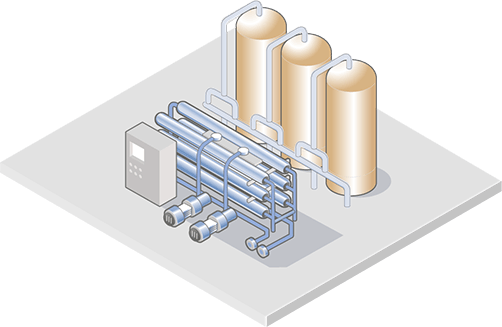Industrial Waste Water Treatment-- Industrial-Grade Water Purification and Purification Solutions
Wiki Article
Secret Methods in Industrial Waste Water Treatment Procedures
The therapy of commercial wastewater is a critical element of environmental administration, entailing a range of techniques developed to alleviate the effect of impurities. Innovations in technologies such as membrane filtration and advanced oxidation processes provide ingenious services for improving treatment effectiveness.Physical Therapy Techniques
Exactly how successfully can physical therapy techniques attend to the complexities of industrial wastewater? Physical treatment methods play a critical role in the initial phases of wastewater administration, focusing primarily on the elimination of solids and huge particulates. Techniques such as filtration, sedimentation, and flotation protection are essential for reducing the focus of put on hold solids, thus enhancing the efficiency of succeeding treatment processes.Sedimentation entails the gravitational settling of solids, enabling for the separation of larger materials from the wastewater. This method is especially reliable in clearing up water prior to chemical or biological therapies.
Additionally, flotation protection approaches, which use air bubbles to raise suspended solids to the surface area for removal, work in dealing with wastewater with high concentrations of fats, oils, and oils. In general, physical therapy methods function as an important very first step in the thorough administration of industrial wastewater, guaranteeing that the tons on subsequent therapy phases is reduced and boosting overall treatment efficiency.
Chemical Therapy Techniques
While physical treatment approaches prepared for effective wastewater monitoring, chemical treatment strategies are necessary for dealing with the more complicated contaminants usually discovered in commercial effluents. These approaches use various chemical agents to speed up, reduce the effects of, or oxidize harmful compounds, ensuring a much more thorough elimination of toxins.
One typical strategy is coagulation and flocculation, where chemical coagulants such as aluminum sulfate or ferric chloride are included to advertise the aggregation of put on hold fragments. This process improves solid-liquid splitting up, decreasing turbidity and enhancing water quality. Furthermore, neutralization procedures are used to adjust the pH of wastewater, utilizing bases or acids to neutralize acidic or alkaline streams, respectively.
Oxidation-reduction responses play a crucial function in derogatory natural contaminants and pathogens. Chemical oxidants like ozone, chlorine, or hydrogen peroxide are made use of to break down complex organic substances, making them much less unsafe or more naturally degradable. In addition, progressed oxidation processes (AOPs) integrate several oxidation strategies to boost contaminant removal effectiveness.
Organic Therapy Procedures
The performance of wastewater therapy is significantly enhanced by biological treatment procedures, which harness the all-natural metabolic tasks of microbes to decay raw material and eliminate contaminants. Industrial Waste Water Treatment. These processes mostly include anaerobic and aerobic digestion, each customized for details kinds of wastewaterCardio therapy processes utilize oxygen to sustain microbial development, advertising the break down of organic pollutants right into carbon dioxide and water. Common methods consist of triggered sludge systems, where look at here aeration tanks promote the blending of wastewater with bacteria, and trickling filters, which encourage biofilm growth on media surface areas.
On the other hand, anaerobic treatment procedures happen in the absence of oxygen, utilizing anaerobic microorganisms to break down raw material, leading to biogas production, a renewable energy resource. Anaerobic digesters are commonly utilized in commercial setups for this purpose, properly decreasing the volume of sludge while producing valuable biogas.
The option of a biological treatment method depends on wastewater features, therapy objectives, and regulatory standards. The combination of biological processes in wastewater therapy not only boosts contaminant elimination effectiveness but likewise promotes sustainability by decreasing chemical usage and sustaining resource healing.
Advanced Oxidation Processes

Typical AOP techniques consist of Fenton's photocatalysis, ozonation, and reagent. Fenton's reagent, a combination of hydrogen peroxide and ferrous iron, militarizes the formation of hydroxyl radicals, making it reliable for treating wastewater having phenolic compounds and various other recalcitrant materials. Ozonation makes use of ozone as a powerful oxidant, qualified of deteriorating a variety of natural pollutants while all at once disinfecting the effluent. Photocatalysis utilizes light-activated catalysts, such as titanium dioxide, to enhance oxidation responses and eliminate impurities.
AOPs use numerous advantages, including minimized sludge manufacturing and the ability to treat wastewater with high concentrations of natural toxins. The implementation of AOPs requires careful consideration of operational specifications and cost-effectiveness, making sure that these sophisticated methods are properly incorporated right into existing wastewater therapy systems.
Membrane Filtration Technologies

Microfiltration works for removing suspended microorganisms and solids, while ultrafiltration targets smaller organic particles and infections. Nanofiltration bridges the space between ultrafiltration and turn around osmosis, properly removing divalent ions and organic compounds. Reverse osmosis supplies the highest possible degree of filtration, made use of primarily for desalination and removing mono-valent ions.
Membrane layer modern technologies supply numerous advantages, including low power consumption compared to traditional treatment methods, modular design for scalability, and the potential for water recuperation and reuse. Difficulties such as membrane fouling and the need for regular upkeep have to be resolved to make sure system effectiveness. Generally, membrane filtration technologies stand for a crucial element of contemporary commercial wastewater therapy methods, promoting sustainability and source preservation in water administration.
Conclusion
In conclusion, commercial wastewater therapy utilizes a varied array of methods, consisting of physical, chemical, biological, and progressed approaches. Continued improvements in these methodologies will better improve the effectiveness his explanation and performance of wastewater treatment processes in industrial setups.The therapy of industrial wastewater is an important aspect of environmental administration, entailing a range of techniques created to minimize the effect of impurities.How efficiently can physical therapy approaches resolve the complexities of industrial wastewater?Advanced oxidation processes (AOPs) represent an innovative strategy in industrial wastewater treatment, developed to efficiently break down natural toxins that are often resistant to conventional treatment methods (Industrial Waste Water Treatment).In conclusion, industrial wastewater treatment employs a diverse range of methods, including physical, chemical, biological, and advanced methods. Continued advancements in these methodologies will further improve the efficiency and effectiveness of wastewater therapy procedures in commercial setups
Report this wiki page